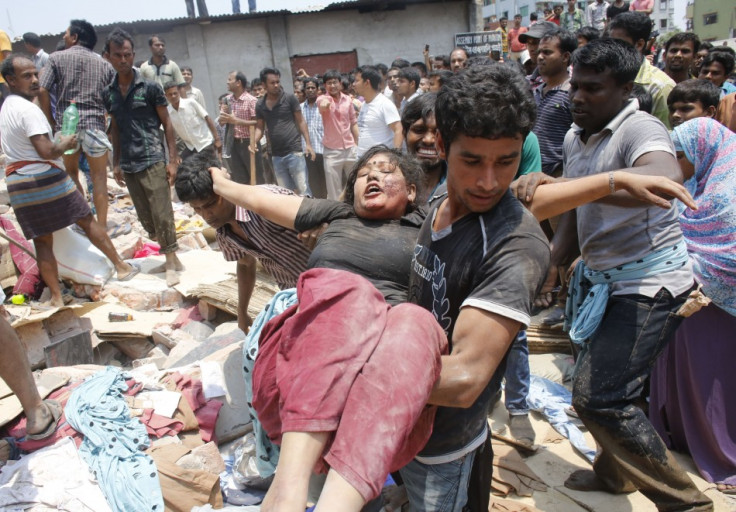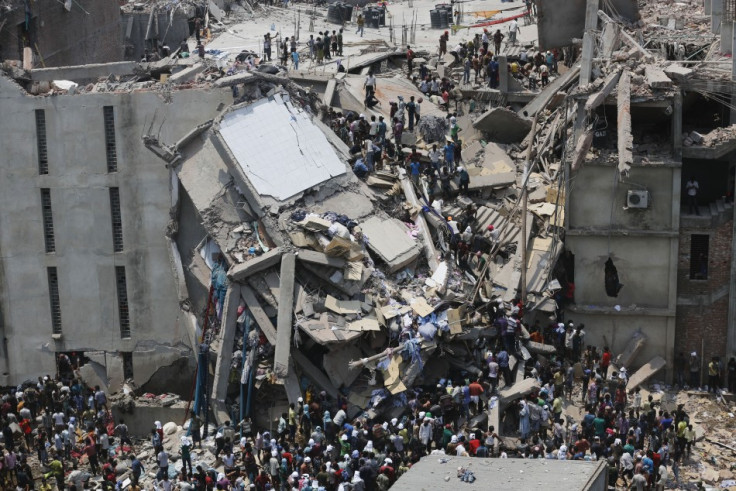Bangladesh Factory Disaster: Workers Made Clothes for Benetton, Primark and Dress Barn
Hundreds of workers missing in Dhaka building collapse where garment factories made clothes for some of the world's biggest retail chains

Hundreds of workers are still feared missing in the Dhaka building collapse, as it emerged that the garment factories which occupied many of its floors made clothes for some of the biggest retail chains in the US and Europe.
Among the businesses in the building were Phantom Apparels, New Wave Style, New Wave Bottoms and New Wave Brothers, which make clothing for worldwide brands including Benetton, The Children's Place and Dress Barn. The Telegraph reported that factories there also produced fashion lines for British high street names such as Primark, Matalan and Bonmarche.
Benetton denied that "people [caught] in the collapse of the factory" were its suppliers.
Matalan said: "We can confirm that New Wave has been a supplier to Matalan although we don't have any current production with them. We are deeply saddened by the news and we have been trying to get in touch with our contacts since we heard to check if we are able to assist."
The last time New Wave supplied Matalan was in February, a spokesman added.
Widespread problem
According to Liana Foxvog, of the International Labor Rights Forum (ILRF), the collapse eerily echoes the Spectrum factory collapse in Bangladesh in 2005, in which 64 people were killed and 80 were injured. Garment factories in Bangladesh, the world's biggest exporter of clothing after China, are often located in unsafe buildings originally constructed for residential or commercial purposes.
Thousands of workers and residents were believed to be inside Rana Plaza when it collapsed. Many of the dead were women and there are fears that children left in creches will be added to the mounting death toll.
Hundred of people were feared trapped and rescue workers reported hearing people reciting prayers and crying out from beneath tonnes of tangled wreckage.
"These buildings were made for residential purposes, not for heavy industries with overloads of people and machines," said Foxvog.
"They don't have fire emergency exits or external fire escapes like those on apartment buildings in the US and the UK. They don't have fireproof staircases and use instead a collapsible metal gate."
A huge crack appeared in the building 24 hours before the collapse but the factory owners had ordered their workers to return to work.
One survivor, Shaheena Akhter, 23, said that she and her colleagues had returned to work only after being threatened with dismissal. Sobbing and anxious to resume her search for missing friends, she said: "Some of us did not want to work fearing something might happen, but the garment factory people told us that we had to join our work otherwise we will lose our jobs.
"We started working and at around 9am the building collapsed. Somehow I managed to leave the building. I really am not sure how. I was inside the building and somehow I managed to get out. I can't describe it. God saved me. Somehow how I managed to escape."
The incident raises further questions over safety and working conditions in Bangladesh's £13bn garment industry.
"The vast majority of Bangladesh's 5,000 factories are not compliant with safety measures," Foxvog continued. "If they were operative in the US or the UK they would have been told to shut down immediately."
"This tragedy is a wake-up call for all the multinationals to provide sufficient funding to factories," she said. "Building should become compliant with safety measures."
The incident happened just six months after fire swept through the Tazreen Fashions factory in Bangladesh, killing 111. The blaze was blamed on an electrical fault.
Since then, 40 more factory incidents have led to the deaths of 10 people, with 650 workers injured.
"The building collapse is one of several incidents," Foxvog said. "It's a widespread problem that needs a widespread solution."
The ILRF has set up a comprehensive fire safety programme, Bangladesh Fire and Building Safety Agreement, to address the decades-old problem of lethal working conditions in supply factories.
"We urgently need the Fire and Building safety agreement to ensure supervisors listen to workers when they report of cracks in the building," she said. "Instead in this case, workers were told not to worry and keep working."
Scandalous human tragedies
According to ILRF research, since 2005 more than 700 garment workers have died in unsafe buildings in Bangladesh. The programme, which has been accepted by major buyers such as PVH Corp (Tommy Hilfiger, Calvin Klein) and Tchibo, features independent inspections by trained fire safety experts, public reporting, mandatory repairs and renovations, a central role for workers and unions in oversight and implementation, and supplier contracts with sufficient financing and adequate pricing.
"It's a binding contract between brands and workers, different from business-as-usual measures," said Foxvog. "It's legally binding and implies a role for workers and brands."
Laia Blanch of War on Want said that international clothing brands were ultimately to blame for failing to insist that Bangladeshi suppliers used safe factories.
"It is dreadful that leading brands and governments continue to allow garment workers to die or suffer terrible disabling injuries in unsafe factories making clothes for Western shoppers," she said.
"How many more lives must be lost or crushed before ministers and companies act to stop these scandalous human tragedies?"

© Copyright IBTimes 2025. All rights reserved.






















